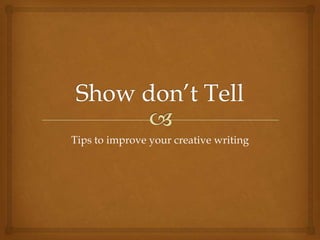
Show don’t tell
- 1. Tips to improve your creative writing
- 2. When you are describing, A shape, or sound, or tint; Don't state the matter plainly, But put it in a hint; And learn to look at all things, With a sort of mental squint. ~Charles Lutwidge Dodgson (Lewis Carroll)
- 3. Good writing seldom involves large slabs of exposition which tell the reader what is happening. If the author interrupts too many times the reader may feel as though the characters are just cardboard cut-outs, puppets whose strings are clearly visible.
- 4. Instead, the writer should aim to make the reader feel that the characters exist in their own way, on some alternate plane, and that what is happening to them is real. Showing, not telling is crucial to turning your story ideas into writing that comes alive.
- 5. Use Action Verbs Aim to create strong, rather than washed out writing. John Gardner in The Art of Fiction favors a more direct presentation of events as opposed to the weak descriptions that characterize mediocre writing. For example, “Turning, she noticed two snakes fighting in among the rocks,” could be changed from passive to active easily. “She turned. In among the rocks, two snakes whipped and lashed, striking at each other.” (Gardner 98).
- 6. Often when we write we tell, because that is our mind plays out the scene and that is fine for a first draft. In the vital editing and revising stages we need to slash and tear out all the unnecessary words, the explaining that will only drive the reader to boredom, and make sure we are showing the scene.
- 7. Don’t explain every detail. Connie Shelton in Show, Don’t Tell, gives a very good example. Telling: I went to the store to pick up some potato chips. My neighbor, Elsa Brown, was pushing her cart down the aisle, looking at the canned soups. I remembered tht Bill and I had talked about inviting Elsa and her husband Charlie to dinner one night this week so the men could discuss a business deal. But Elsa’s son had said some mean things to our daughter on the playground a few days ago, hurting her feelings. This was going to be awkward but I knew I needed to clear the air (85).
- 8. Showing: Elsa Brown stood there, staring at the canned soups. I rounded the corner and pulled up short. Awkward moment. Bill wanted me to invite Else and Charlie to dinner—something about that big merger. But how could I forgive…? I must have squeezed my bag of chips. Else looked toward the cackling sound. “Beth, hi!” “Elsa.” I felt the chips crush. “I, uh…” “Look I’m glad I ran into you. I wanted to apologize for Danny’s comments to Ashley the other day. I sent him over to apologize but I guess you guys weren’t home. I felt a smile at the corners of my mouth. “Hey how about you guys come over for burgers tonight?” (99)
- 9. The second example gives far more detail, we see the characters as real people. Notice the use of clues for background? In the first example we are told Bill is a business man who wants to talk business with Charlie, in the second we are given clues, “something about that big merger.” It is always far more exciting when something is hinted at rather than spelled out.
- 10. Visit my Blog to read more http://ms-ferrari.blogspot.com/2012/08/show-dont- tell.html
- 11. Works Cited Gardner, John. The Art of Fiction: Notes on Craft for Young Writers. New York: Vintage, 1991. 98. Print. Shelton, Connie. Show Don't Tell: Five Secrets to Solving the #1 Problem in Fiction Writing. Connie Shelton. 85-99. Kindle.